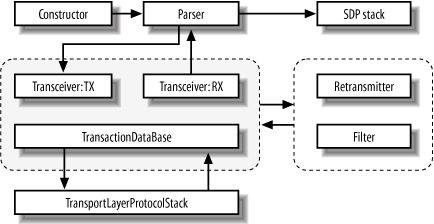Chapter 8. Vovida SIP Stack
Now that you’ve had the user guide tour about how SIP works, let’s go a little deeper into the architecture and talk about the classes, modules, and threads that we implemented into our SIP stack.
Throughout this chapter, when we refer to a certain protocol stack, we’re referring to Vovida’s implementation of the standard that governs that stack.
If you don’t have a background in software development, you may find the remainder of this book’s content difficult to digest. You could help yourself by brushing up on the Unified Modeling Language (http://www.rational.com/uml/index.jsp), object-oriented design, C++, and data structure and theory, which, unfortunately, require a few years of schooling to understand.
Architecture
Figure 8-1 shows how the major components of the SIP stack work together and with other protocol stacks.

Figure 8-1. SIP stack components
These processes are defined as follows:
- Constructor
Builds messages, either as brand-new requests or as reconstructions of received responses.
- Parser
Encodes and decodes messages.
- SDP stack
Encodes, decodes, and alters Session Description Protocol (SDP) bodies.
- SIP transceiver
Includes five components, listed next. An intelligent structure, it matches requests with responses, and responses with acknowledgments.
- Transceiver: TX
Transmits messages over a transport layer -independent interface.
- Transceiver: ...
Get Practical VoIP Using VOCAL now with the O’Reilly learning platform.
O’Reilly members experience books, live events, courses curated by job role, and more from O’Reilly and nearly 200 top publishers.

